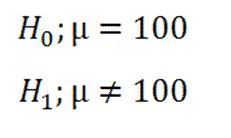Here's an example: Researchers want to test a new medication that claims to raise IQs to genius levels (175+). In the population, the average IQ is 100. A sample of 40 individuals has a mean IQ of 110 with a standard deviation of 15.

|
Figure 1. |
|---|
A t-test is performed and the null hypothesis is rejected. It is concluded that the medication raises IQ.
To reject the null hypothesis is to say that you have found statistical significance.
But the medication claimed to raise IQs to genius (175+) levels. Even though we found statistical significance, the medication does not meet the practical value it claimed to. While the medication works, it doesn't increase intelligence levels to the genius level it claimed to. It lacks practical significance.